Over several years of researching and writing about the AFL Chargers, I have heard many great stories from fans that grew up in the 1960s, and were fans of the team. Like many AFL fans, I’m sure, these fans had wonderful memories of watching Chargers practices, catching games at Balboa Stadium, and the excitement of having Lance Alworth attend their father’s Elk’s Club meeting to show a highlight film and talk about season ticket packages.
Bill Denhart is one of those lucky Chargers fans, and a few weeks back I asked Bill if he would be interested in writing a piece about attending Chargers practices when he was a kid growing up in La Mesa. Bill took the project even further than I had imagined, speaking to his brothers and childhood friends, puling out many old, but enjoyable memories. The following story was written by Bill for our enjoyment. ~ Todd
On September 12, 2013, Todd posted an interesting video from 1960 showing the Boston Patriots practicing at what appears to be a public park or school. It was from an old home movie. In the film clip you can see kids and grownups watching the team practice. In his introduction Todd mentioned that he had heard stories of kids and fans attending Charger practices at Sunset Park in La Mesa when the Chargers practiced there from 1964 through 1973. Todd emailed me and asked if I could share my remembrances of Charger practices since I lived right across the street from Sunset Park on Lake Murray Boulevard.
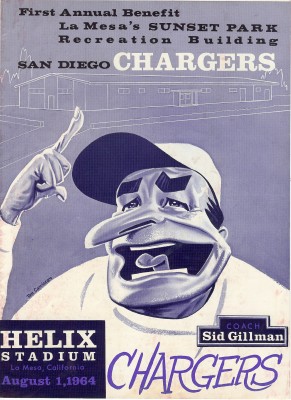 During the summer of 1964 anticipation was high in the neighborhoods surrounding Sunset Park as the word on the street was that the World Champion San Diego Chargers would be conducting their in-season practices at the park. Some of us could not believe it until August 1, 1964 when the Chargers conducted a scrimmage at Helix High School to help raise funds to construct a new recreation building at the park, which would also serve as the meeting and locker facility for the team. The Helix stadium was filled to capacity and fans were invited to mingle with the players on the field. As a 13 year old I remember that Tobin Rote looked old and Ernie Ladd was huge. Sid Gillman emceed the event and he had Ernie Ladd demonstrate some wrestling maneuvers with Jacque MacKinnon as Ernie’s foil.
During the summer of 1964 anticipation was high in the neighborhoods surrounding Sunset Park as the word on the street was that the World Champion San Diego Chargers would be conducting their in-season practices at the park. Some of us could not believe it until August 1, 1964 when the Chargers conducted a scrimmage at Helix High School to help raise funds to construct a new recreation building at the park, which would also serve as the meeting and locker facility for the team. The Helix stadium was filled to capacity and fans were invited to mingle with the players on the field. As a 13 year old I remember that Tobin Rote looked old and Ernie Ladd was huge. Sid Gillman emceed the event and he had Ernie Ladd demonstrate some wrestling maneuvers with Jacque MacKinnon as Ernie’s foil.
Sunset Park, just east over the hill from Lake Murray, opened in 1963 with a Little League field, an outdoor basket court, a playground and some picnic tables. The following year saw the construction of the building that served as the Charger practice facility for ten years and is now the Challenge Rehabilitation facility. The neighborhoods near Sunset Park were annexed by the City of La Mesa a few years before the Chargers arrival and it was an area in transition. The Maryland Heights area was changing from an area noted for its small ranches, farms and poultry production. The early 1960’s saw the closing of the poultry ranch behind the Murray Lake Store, the Pekelder Poultry and Egg Ranch just east of Sunset Park and the Hollinger Turkey Ranch near Aztec Drive and Lake Murray Boulevard. The large produce fields north of Lake Murray Boulevard between Baltimore Drive and Aztec Drive were being sold off to developers. Yet some residences around Sunset Park still had horses and livestock until the 1980’s (more about this later). The Chargers first season in Los Angeles (1960) was also the last year duck hunting was allowed at nearby Lake Murray.
The Chargers conducted their 1964 preseason camp in Escondido. To the kids in the Maryland Heights, Murray Manor and Rasonia neighborhoods it seemed as though the Charger regular season would never start, which would mean the arrival of the Chargers to our world. I remember being at Sunset Park with some friends one Sunday afternoon when a car pulled up and out stepped Paul Lowe with his wife and kids. He was obviously there to check out the new facility where his team would soon conduct practices. We just stood in awe and watched. We knew it was Paul Lowe but one kid had to ask him “are you Paul Lowe?”, as though we could not believe our good fortune. Finally, the 1964 Chargers broke camp and began practicing at Sunset Park. I remember the first practice at the park drew hundreds of people. I could tell Gilman was not real happy but what could he do? It was a City of La Mesa public park. I remember that first practice standing by the outdoor basketball courts above the field watching Joe Madro’s offensive linemen practicing against the five- man blocking sled. I could tell even as a 13 year old Pop Warner veteran Joe was not real happy with his new left guard Walt Sweeney.
Soon after, kids went back to school and both kids and the Chargers settled into a daily routine. After school we could sometimes hear the coach’s whistles from our homes so we would hustle over to the field. It was fun to watch the Chargers. I remember helping Alvin Roy store some practice supplies and weights in the little league dugouts. Others, including my younger brothers, told me stories of hanging around until practices ended so they could help out in some way. Often, the placekickers and punters would stay on the field after practice kicking. The only ones retrieving their footballs were the neighborhood kids, which the Charger kickers appreciated. Many remembered the girlfriend who would hold placekicks for her Charger boyfriend. No one could remember the kicker’s name but they remembered the young lady. Often, backup quarterbacks would want to get some extra work and draft neighborhood kids to run routes. One of my younger brothers still claims the black mark on his chest is an old bruise caused by a spiral from Marty Domres. The neighborhood kids soon learned as long as we behaved ourselves we could stay on the periphery and watch. On weekends during the season the practice field for the most part returned to the neighborhood kids who would play football or attempt to kick field goals through the portable goal post. One Saturday morning there was a big touch football game going on among the neighborhood kids when the Chargers started to trickle down to the field for a practice. We kept on playing as the entire Charger squad waited on the sidelines watching us. Finally, Sid came down and asked us to take our game to the little league field so his team could practice. I’ve always remembered that he addressed us as ‘men’. My younger twin brothers still talk about the time late in a Charger season they were playing a touch football game on the little league field behind the portable goalpost as the Chargers were practicing nearby. The football my brothers and their friends were using was an old slick herniated football that was probably ten years old and had spent too much time on asphalt being used in street games. Shoestrings were the laces. Somehow the football trickled over near a defensive back. The DB picked it up and lateraled it toward the Charger huddle and it was placed at the line of scrimmage. The Chargers broke huddle and Sam Gruneisen crouched over the football. Sam hiked the football to John Hadl, who then passed it to Lance Alworth. The Chargers kept using this old football so much my brothers and their friends thought they would never get the football back. They stood silently watching as the Chargers kept running play after play with this old football. The football was finally hand delivered back to them by a Charger with a big grin on his face.
As time marched on the Chargers became ingrained into the everyday fabric of daily life in the community. My sister went to school with one of Chuck Allen’s daughters at St. Martin’s Academy in La Mesa. Loraine and Ray Foster owned the Murray Lake store on Lake Murray Boulevard and they talked with joy about the Chargers who would stop in for an Icee drink after practice. Gene Drysdale owned the Chevron Station at Lake Murray Boulevard and Maryland Avenue and serviced cars belonging to Charger players while they practiced. One defensive back bounced a check for some repairs shortly before he was cut and Gene wasn’t paid. Gene proudly displayed the check with other bounced customer checks. But most of the stories were good. Everyone I talked to for this story talks about how nice the players were to the kids. Some talked about tailing Charger players on their bikes as the Chargers jogged over the hill to Lake Murray for some roadwork. Many of the players rented apartments in the area. Some of the kids knew where they lived and would purposely go trick-or-treating to their residences. My younger sister had a pony. After school she would ride the pony over to the park, patiently waiting for practice to end. She would ride her pony on the field after practice and make money by charging neighborhood kids a quarter to ride her pony. She said many Charger players would come over and pet the pony.
The Chargers learned to live with the area residents and install a few measures for security. A tarp was installed on the chain leak fence by the basketball courts yet it still had gaps you could peak through. The wooden fence around the field also offered many holes to peek through to get a good look at practice. It was no problem to access the little league field. The defensive lineman of the Chargers conducted many drills in right field and we liked to watch them from the infield or behind the first base dugout. Because the outdoor basketball courts were near the locker room entrance, you could hang out there and watch for players as they walked in and out of their locker facility. The locker room was off limits. That still didn’t stop some kids from just casually trying to blend in to see how far they could get in before being discovered. It was all in good fun.
Of course being kids we sometimes would go dumpster diving behind the facility. Many a teenager who played football at Helix or Saints wore football cleats or pads courtesy of the Chargers that were rescued from the dumpster. We learned some things about life from that dumpster. My younger brother tells the story about finding a stack of leaflets with an invitation to an after game party at the home of John Hadl. In big block letters at the bottom of the sheet was written BYOB. What the heck did BYOB mean? He finally showed it to our father, who happened to be in the wholesale liquor business. With a smile on his face he explained what BYOB meant. My young brother not only learned what BYOB meant but he was a little chagrined to learn that the Charger players drank alcohol during the season. Todd has chronicled from his interviews with Charger players stories about the three game eastern trips the team used to take during the season. Judging from the letters from east coast fans that ended up in the dumpster it appeared that some Chargers did indeed have a good time. As teenage boys we read these letters with great interest. There were also many letters to Charger players thanking them for participating in community, school and youth activity events.
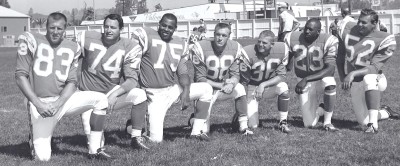
Original Chargers Dave Kocourek, Ron Mix, Ernie Wright, Don Norton, Dick Harris, Paul Lowe and Don Rogers at Escondido training camp in 1964, shortly before moving to Sunset Park for regular season practices.
Probably hundreds of kids have stories about watching the Chargers at Sunset Park. The Chargers practiced there for 10 years. When the Chargers started practicing there in 1964 they still had original Chargers Paul Lowe, Ron Mix, Don Norton, Emil Karas, Don Rogers, Charlie McNeil, Ernie Wright, Dave Kocourek and Dick Harris on the team. The last year (1973) at Sunset Park the team had Johnny Unitas, Deacon Jones, and old Charger nemesis Mike Stratton on the roster. The one constant from 1964 to 1973 was Walt Sweeney. The 1973 team also had the beginnings for Air Coryell in Dan Fouts, Russ Washington and Doug Wilkerson. The neighborhood also got to enjoy Lance Alworth, Tobin Rote, John Hadl, Ernie Ladd, Paul Lowe, Keith Lincoln, Dickie Post, Frank Buncom, Earl Faison, Gary Garrison and many others. Sid Gillman, Chuck Noll, Bum Phillips, Tom Bass and Joe Madro coached on that field. Players came and went over the years. I remember watching an early 1969 workout on the field and noticed that defensive tackle Scott Appleton was standing on the sidelines with helmet in hand. I remember wondering why he wasn’t participating in the drills. A day or two later I read that he was waived. It was a stark lesson about life in pro ball.
What’s interesting is that everyone I talked to for this article said they never asked for an autograph. I’m sure there were many requests from kids over the years but for most of the neighborhood kids we were just happy and content just to have the team practicing at Sunset Park. After watching Todd’s video of the 1960 Boston Patriots I regretted not taking some pictures. I’m sure the neighborhood and La Mesa offered the team a lot and the team repaid it back many times over to the community. A rumor for years was the go-cart that kids constructed from an old frame found in the trash in the Maryland Avenue neighborhood had front tires that sure looked like the missing tires of the portable goal post at Sunset Park.

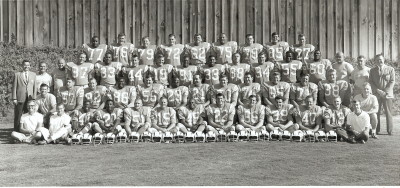
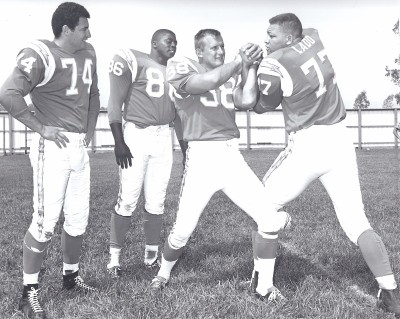
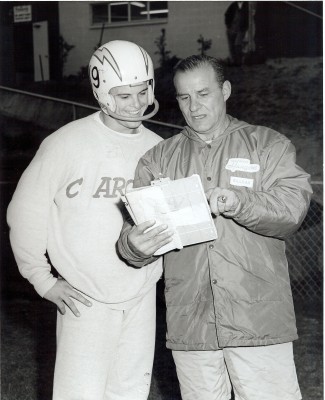
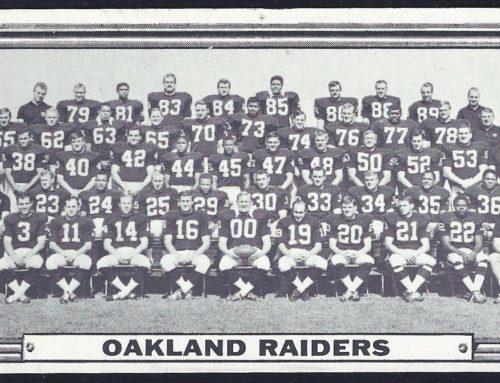
Great stories and great memories about a great team — the early San Diego Chargers, circa 1960’s. Thanks for sharing, Bill and Todd!
Loved the article on attending the Chargers practices. Growing up only a few miles from the Oakland Coliseum, I did the same thing in the early 70s age 12-14 (pre-BART)and have many similar stories including retrieving field goal kicks of George Blanda in Oakland and Garo Yepremian when the Dolphins practices unannounced at a local high school I happened to be at.
The season ticket highlight films were also another memory.
In a box somewhere stored away I have all the memorabilia, autographs, give-aways programs etc from that special time
‘Bias: I remember Chargers practicing at Stardust Country Club in 1972. It swas to the West of the pro shop on the Freeway side.
Sid Brooks in his book Tales From the San Diego Chargers Locker Room talks about the Chargers conducting their spring 3 day mini camp in an open field in the southeast corner of the golf course at the Stardust in the early 70’s.
Wonderful stuff!
A great, great, article. It makes me realize how much the youth of today is missing.Every generation of people remembers the”old days”, but the current generation with all of their technical gadgets is missing the boat on a lot of things, including appreciating the pureness and values in sports.
I coached youth soccer at Sunset Park in La Mesa in 1972 and 1973. The name of our team? The RAIDERS !
… [Trackback]
[…] Read More to that Topic: talesfromtheamericanfootballleague.com/my-childhood-with-the-chargers/ […]
… [Trackback]
[…] There you can find 95756 more Info to that Topic: talesfromtheamericanfootballleague.com/my-childhood-with-the-chargers/ […]
… [Trackback]
[…] Info on that Topic: talesfromtheamericanfootballleague.com/my-childhood-with-the-chargers/ […]
… [Trackback]
[…] Read More on that Topic: talesfromtheamericanfootballleague.com/my-childhood-with-the-chargers/ […]
… [Trackback]
[…] Information on that Topic: talesfromtheamericanfootballleague.com/my-childhood-with-the-chargers/ […]
… [Trackback]
[…] Read More on on that Topic: talesfromtheamericanfootballleague.com/my-childhood-with-the-chargers/ […]
… [Trackback]
[…] Find More on that Topic: talesfromtheamericanfootballleague.com/my-childhood-with-the-chargers/ […]
… [Trackback]
[…] Read More on that Topic: talesfromtheamericanfootballleague.com/my-childhood-with-the-chargers/ […]
… [Trackback]
[…] Find More Information here to that Topic: talesfromtheamericanfootballleague.com/my-childhood-with-the-chargers/ […]
… [Trackback]
[…] Info to that Topic: talesfromtheamericanfootballleague.com/my-childhood-with-the-chargers/ […]
… [Trackback]
[…] Info to that Topic: talesfromtheamericanfootballleague.com/my-childhood-with-the-chargers/ […]
… [Trackback]
[…] Find More on that Topic: talesfromtheamericanfootballleague.com/my-childhood-with-the-chargers/ […]
… [Trackback]
[…] Info to that Topic: talesfromtheamericanfootballleague.com/my-childhood-with-the-chargers/ […]
… [Trackback]
[…] Read More Info here to that Topic: talesfromtheamericanfootballleague.com/my-childhood-with-the-chargers/ […]
… [Trackback]
[…] Find More to that Topic: talesfromtheamericanfootballleague.com/my-childhood-with-the-chargers/ […]
… [Trackback]
[…] Find More on to that Topic: talesfromtheamericanfootballleague.com/my-childhood-with-the-chargers/ […]
… [Trackback]
[…] Read More on that Topic: talesfromtheamericanfootballleague.com/my-childhood-with-the-chargers/ […]
… [Trackback]
[…] Read More Information here to that Topic: talesfromtheamericanfootballleague.com/my-childhood-with-the-chargers/ […]
… [Trackback]
[…] Read More Information here on that Topic: talesfromtheamericanfootballleague.com/my-childhood-with-the-chargers/ […]